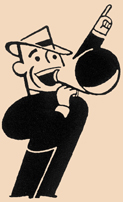

Spinning Your Web
by
Katie Davis
When you have a new book you want to promote (or new show or gig) it's great to use your web site to do the work for you. As illustrators we have a distinct advantage when designing our sites since the web is a visual world. It's much more personal, as well as gratifying, to come across a site that conveys a real feeling for the person it represents, or at least, how that person is presenting him or herself professionally.
I know, this is totally obvious for those who think visually. But how about less obvious things? Here are some suggestions that you can do specifically as an illustrator that will help the site promote your new book.
1. Work with your author
Of course, first you may have to find your mystery writer, since authors and illustrators are deliberately kept apart so often. However, if it'll sell more books, you may have a better shot at getting some contact info from your publisher. Let's assume the two of you do know each other (and going with statistics and simplicity, let's assume she is a female). Offer her art from the book to put on her site. By this I mean send scanned art, or jpegs for her to upload. This will multiply the exposure for you both. Include reciprocal links on your sites and your readers will get double their money's worth too.
2. Make activity pages
I actually have a lot of fun making these. I used to make them by hand, then I used the puzzle maker at http://puzzlemaker.school.discovery.com, until I finally purchased a program (on that same site) that allows me to configure puzzles and games using words from my books. I include some line art from the book and my URL, save as a PDF and upload it to my site. Now anyone can download and distribute them. Kids play with them, teachers and librarians use them to prepare students for my visits, stores can (hopefully) stack them by the cash register as freebie giveaways.
3. Include "never before seen footage"
I absolutely love to see another illustrator's process. It's such a personal thing it's hard to imagine what others go through. When I go to conferences, one of my favorite things is to watch an illustrator's presentation and view work that didn't make it into the book, or see the progression of one particular piece of art.
I've included an "outtakes" page on my site. It's fun for kids to see how an awful sketch can turn into something fabulous with work. It also teaches them that even grown ups have to erase a lot before getting it right.
4. Include reference material
I saw a great presentation by G. Brian Karas (http://www.gbriankaras.com) where he showed slides he took for reference. It was fascinating to see how an old street in New York City became a lighted path for the Cinderella character in his book, CINDER ELLY (written by Frances Minters). Inspired, I included a picture on my site of my dentist next to the illustration of Dr. Les Payne, D.D.S. I did for MABEL THE TOOTH FAIRY. It's just one little thing, but it's fun, and lends depth to the site.
Cynthia Leitich Smith is an author who has included something really creative and unusual on her site (particularly since she isn't an illustrator). She has gotten a lot of positive feedback for building a virtual town based on the fictional one that was the setting for her book RAIN IS NOT MY INDIAN NAME. (http://www.cynthialeitichsmith.com/rainisnotmyindianname.html)
5. Give a studio tour
Even if your "studio" is the left corner of the kitchen table, take some pictures of it and put it on your site. You can play with it... "here is the spot where I place my coffee every morning as I start to work..." People are very interested in where we create. I think it comes from that ubiquitous "I can't even draw a stick figure" thing. And what we do is very different from most jobs, so showing a bit of our world is pretty cool to an outside observer (or, frankly, even to an insider observer).
You are probably already aware of the basics: make your site easy to navigate. Know your audience and tailor it to them. Upload or link good reviews and articles. But don't forget to promote it, after you've done all this work! Web designer Janni Lee Simner (http://www.simner.com/web.html) told me, "Put the address of your site everywhere you can--not only on lists of author sites online, but also on any print promotional materials you produce, and if possible in the book itself. Just having it "out there" on the web doesn't do much; people need to know the site (or illustrator) is out there in the first place in order to know to look for it."
To learn more about Katie and her books visit www.katiedavis.com
![]()